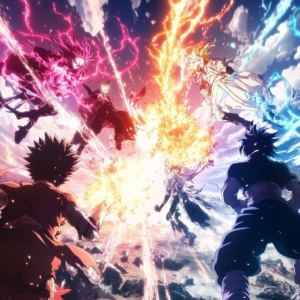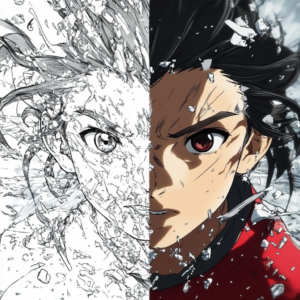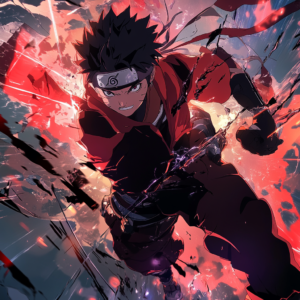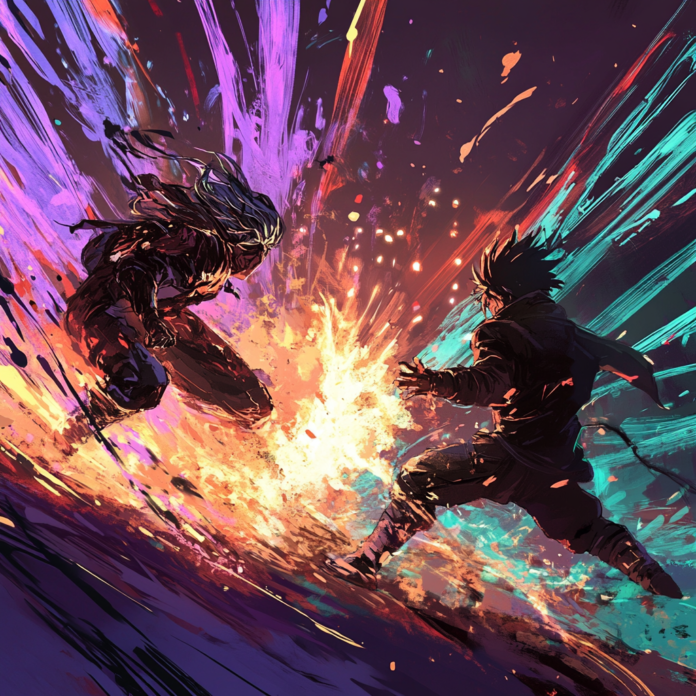1. Introduction
Anime fight scenes are not merely sequences of physical combat; they are meticulously choreographed spectacles that merge storytelling, emotion, and cutting-edge animation techniques. In this comprehensive guide, Analyzing the Best Anime Fights: Top Battles Ranked, we dive deep into what makes these battles legendary. Our focus keyword, Analyzing the Best Anime, will lead you through an exploration of epic confrontations, detailed case studies, and discussions on their cultural impact.
In today’s competitive entertainment landscape, understanding the nuances behind iconic fight scenes can elevate your viewing experience and deepen your appreciation for the art of animation. For additional insights into innovative anime storytelling, please visit Breaking Down the Latest Anime Movie Plot Twists and join discussions on Exploring Anime Fandom: Trends, Theories and More.

2. The Evolution of Anime Combat
The evolution of anime combat reflects the overall growth of the medium—both technologically and narratively. This section is divided into several dynamic segments that illustrate the journey from early, simplistic fight scenes to today’s complex and emotionally resonant battle sequences.
2.1. The Early Days of Anime Combat
In the beginning, anime fight scenes were characterized by their simplicity and exaggeration. Early animations relied heavily on hand-drawn techniques, where movements were often stylized and exaggerated to convey energy and drama despite technological limitations.
- Exaggerated Movements: The focus was on creating a sense of impact through bold, over-the-top actions, even if the animation was not fluid by today’s standards.
- Basic Sound Effects: Sound design was rudimentary, with simple effects that served to punctuate the action rather than enhance the emotional narrative.
- Direct Narrative Function: At this stage, fight scenes primarily served to entertain, with little emphasis on integrating deeper storytelling elements.
This era laid the groundwork for what would eventually become a hallmark of anime storytelling, setting the stage for more sophisticated portrayals of combat.
2.2. Technological Advancements and Narrative Transformation
As animation technology advanced, so did the complexity and quality of anime combat scenes. Digital tools and computer-generated imagery (CGI) began to complement traditional hand-drawn art, enabling creators to achieve smoother, more detailed movements.
- Digital Integration: The advent of CGI allowed for seamless transitions and intricate details in fight choreography, making the battles more visually impressive.
- Enhanced Sound Design: With improved technology, soundtracks and effects became integral to building tension, enriching the overall sensory experience.
- Narrative Depth: Directors started embedding deeper narrative elements into combat sequences, using battles not only as moments of action but also as critical points for character development and plot progression.
This phase marked a turning point where anime fights evolved from simple spectacles into complex narrative devices that could express both physical and emotional conflicts.
2.3. The Convergence of Tradition and Modernity
Today’s anime combat is the result of a harmonious blend between traditional artistry and modern digital innovation.
- Hybrid Animation Techniques: Many contemporary series combine hand-drawn techniques with digital enhancements, preserving the classic feel while achieving a level of fluidity and detail that was once impossible.
- Innovative Visual Effects: Advanced visual effects, such as dynamic lighting, motion blur, and particle effects, now play a crucial role in accentuating the intensity and realism of battle scenes.
- Cultural Continuity: Despite technological progress, many anime continue to draw from traditional martial arts and cultural symbolism, maintaining a connection to their historical roots.
This synthesis of old and new not only elevates the aesthetic quality of anime fights but also enriches the storytelling, providing a multi-layered experience that honors the medium’s heritage while embracing the future.
2.4. Impact on Narrative and Emotional Resonance
The evolution of anime combat is not merely about visual spectacle—it has profound implications for narrative and character development.
- Character Evolution: Modern fight scenes are often pivotal moments that highlight a character’s growth, resolve, and inner conflicts. For instance, a transformation during a battle can symbolize a turning point in a character’s journey.
- Thematic Expression: Battles are frequently used to express larger themes, such as the struggle between good and evil, personal redemption, or the conflict between tradition and modernity.
- Emotional Engagement: The integration of high-quality animation with powerful sound design creates a deeply immersive experience that resonates on an emotional level, leaving a lasting impact on the audience.
These narrative enhancements ensure that anime fights are not only about physical combat but also serve as a conduit for conveying complex emotions and themes, thereby enriching the overall story.
2.5. Conclusion of Anime Combat Evolution
The evolution of anime combat from its humble beginnings to its current state is a testament to the medium’s relentless pursuit of excellence. Each phase—from the exaggerated simplicity of early animations to the sophisticated, multi-dimensional battles of today—has contributed to the rich tapestry of anime storytelling.
This continuous evolution, driven by technological advancements and a commitment to narrative depth, is at the heart of Analyzing the Best Anime fights. It highlights how innovation and tradition come together to create moments that are as emotionally powerful as they are visually stunning, ensuring that every battle scene leaves an indelible mark on both the story and its audience.
3. Essential Elements of Epic Battles
A truly memorable anime fight scene comprises several critical components:
- Choreography and Movement: Fluid, well-orchestrated sequences that reflect each character’s unique fighting style and emotional state.
- Visual Effects: Dynamic lighting, explosive energy bursts, and creative digital overlays that enhance the impact of every strike.
- Sound Design: Powerful soundtracks, crisp sound effects, and effective voice acting build the tension and drama of each battle.
- Narrative Integration: The fight scene should be seamlessly woven into the storyline, advancing character arcs and underscoring thematic conflicts.
- Emotional Resonance: Beyond the physicality of combat, the best fight scenes capture deep internal conflicts and personal growth.
- Pacing and Timing: A well-balanced rhythm, alternating between intense action and reflective pauses, keeps viewers engaged throughout the sequence.
Together, these elements provide a robust framework for Analyzing the Best Anime fights, ensuring that each battle is both a visual spectacle and a narrative milestone.
4. Ranking the Top Anime Fights
While opinions may vary, certain battles have achieved iconic status due to their groundbreaking choreography, emotional weight, and cultural impact. Our rankings include:
1. Goku vs. Frieza – Dragon Ball Z
A seminal battle that redefined animated combat, marked by Goku’s dramatic transformation into Super Saiyan. Its explosive energy and dynamic choreography have become benchmarks for epic battles.
2. Naruto vs. Sasuke – Naruto Shippuden
A climactic rivalry that culminates in emotionally charged duels, symbolizing the deep personal and ideological conflict between the two characters.
3. Luffy vs. Katakuri – One Piece
Celebrated for its innovative animation and character development, this battle showcases Luffy’s growth as he faces a formidable and strategic opponent.
4. Ichigo vs. Ulquiorra – Bleach
A visually striking confrontation that uses minimalistic backgrounds and dramatic lighting to highlight internal conflicts and intense emotional stakes.
5. Levi vs. the Beast Titan – Attack on Titan
A battle blending tactical brilliance with raw power, capturing the high stakes and strategic depth of combat in a dystopian setting.
These battles have each left an indelible mark on the anime landscape and continue to influence both new productions and the broader fan culture.
5. Detailed Analysis of Iconic Fight Scenes
To illustrate what makes these battles truly exceptional, let’s delve deeper into two iconic fight scenes.
Case Study 1: Goku vs. Frieza
In Dragon Ball Z, the epic confrontation between Goku and Frieza is a milestone in anime history.
- Choreography: The sequence escalates through a series of explosive exchanges, culminating in Goku’s transformative moment as he ascends to Super Saiyan.
- Visual Impact: Vivid color transitions, explosive energy effects, and fluid animation create a breathtaking spectacle that has defined a generation.
- Narrative Significance: The battle symbolizes the eternal struggle between good and evil and marks a pivotal turning point in the series.
- Sound Design: The iconic soundtrack, with its soaring crescendos and impactful sound effects, intensifies every moment of the fight.
Case Study 2: Luffy vs. Katakuri
The battle between Luffy and Katakuri in One Piece is celebrated for its complexity and emotional depth.
- Character Dynamics: Luffy’s determination and growth are rigorously tested against Katakuri’s formidable skills, providing a rich narrative of perseverance.
- Technical Innovation: Advanced CGI and dynamic camera angles create a visually immersive experience that highlights the intensity of each move.
- Emotional Resonance: The battle is interwoven with themes of self-improvement and resilience, serving as a critical turning point in the character’s journey.
- Narrative Integration: Every move in the fight contributes to the broader storyline, enriching the overall narrative arc of the series.
For a visual demonstration of these advanced techniques, check out this YouTube video on advanced anime fight scenes.

6. Impact on Genre and Fandom
Iconic anime fight scenes have a profound influence on both the genre and its passionate fanbase:
- Fandom Engagement: Legendary battles spark vibrant discussions, inspire fan art, and drive cosplay trends, uniting fans through shared moments of excitement.
- Influence on Production: The success of epic fight scenes motivates studios to invest in high-quality animation and innovative choreography in future projects.
- Merchandising: Popular battles often lead to a surge in related merchandise—from collectible figures to limited-edition posters—cementing their cultural legacy.
- Cultural Legacy: These battles transcend the screen, influencing other media such as video games and live-action adaptations, and contributing to the overall cultural narrative of anime.
7. Techniques and Innovations in Fight Choreography
Modern anime fights are the result of sophisticated techniques and innovative approaches that enhance both visual and emotional impact:
- Dynamic Camera Work: Multi-angle shots, aerial views, and rapid cuts immerse the viewer in the action.
- Layered Animation: The combination of traditional hand-drawn art with digital enhancements adds depth and fluidity to the movements.
- Precise Pacing: Strategic use of slow-motion sequences and rapid bursts of action builds suspense and emphasizes key moments.
- Advanced Visual Effects: Techniques such as motion blur, particle effects, and dynamic lighting amplify the intensity of each strike.
- Integrated Sound Design: A well-orchestrated soundtrack, complemented by impactful sound effects, synchronizes perfectly with the visuals to heighten emotional tension.
These techniques collectively form the backbone of Analyzing the Best Anime fights, ensuring each scene is both a technical marvel and a narrative highlight.
8. Global Influences and Cultural Significance
Anime is a global art form that draws upon diverse cultural influences, and its fight scenes are no exception:
- Traditional Martial Arts: Many anime incorporate elements from traditional Japanese martial arts, infusing their battles with historical depth, discipline, and honor.
- Modern Cinematic Techniques: Western influences, such as dramatic slow-motion and dynamic editing, have enriched anime fight choreography, enhancing both visual appeal and narrative impact.
- Cross-Cultural Collaborations: International co-productions bring together diverse artistic styles and storytelling techniques, resulting in fight scenes that resonate with a global audience.
- Symbolic Storytelling: Beyond physical combat, many battles serve as metaphors for internal struggles, ethical dilemmas, and the broader battle between light and darkness.
For further insights on cultural influences, you can visit Anime News Network and Rotten Tomatoes.
9. Fan Theories and Interpretations
The anime community is known for its passionate analysis of fight scenes, and numerous fan theories have emerged to explain hidden symbolism and character motivations:
- Hidden Subtext: Fans often uncover subtle visual cues that hint at deeper narrative layers or foreshadow future plot twists.
- Character Psychology: The unique fighting styles of characters can reflect their inner struggles and personal growth, prompting detailed discussions about their emotional journeys.
- Alternate Narratives: Some fans propose that certain battles contain multiple layers of meaning, suggesting alternative storylines or unresolved conflicts.
- Community Dialogue: Through forums, social media, and fan conventions, these theories are continuously refined, contributing to a richer, collective understanding of Analyzing the Best Anime fights.
10. How to Critically Evaluate Anime Fights
For those who wish to delve deeper into the artistry of anime combat, developing critical analysis skills is essential. Here are some guidelines to help you evaluate fight scenes effectively:
- Observe the Choreography: Analyze the sequence and fluidity of movements, considering how they reflect the characters’ skills and emotional states.
- Examine Visual and Audio Elements: Assess the quality of animation, special effects, and sound design. Note how these elements work in harmony to create an immersive experience.
- Contextualize within the Narrative: Consider how the fight scene advances the storyline and contributes to character development.
- Compare Across Scenes: Watching multiple fight scenes can help you identify innovative techniques and recurring motifs that distinguish the best battles.
- Engage with Community Feedback: Participate in discussions on forums and social media to gain diverse perspectives and refine your analysis.
- Document Your Observations: Maintain a journal or digital archive of your insights, which can serve as a reference for future evaluations.
These critical evaluation techniques empower you to transform your viewing experience into an in-depth exploration of narrative, emotion, and technical brilliance—ultimately mastering Analyzing the Best Anime fights.
11. Frequently Asked Questions
Q1: What defines a truly epic anime fight scene?
A1: An epic anime fight combines fluid choreography, high-quality animation, powerful sound design, and deep narrative integration to create a moment that resonates emotionally and advances the story.
Q2: How can I verify the authenticity of anime news?
A2: Use reputable sources like Crunchyroll News and Anime News Network, cross-reference information across multiple outlets, and utilize fact-checking tools such as Google Reverse Image Search.
Q3: Why are expert opinions important in analyzing anime fights?
A3: Expert reviews provide in-depth analysis of technical elements and narrative context, helping to clarify ambiguous details and offer a balanced perspective that enhances overall understanding.
Q4: What are some common tools for verifying anime news?
A4: Fact-checking websites, reverse image search tools, official social media channels, and community discussions are all valuable resources for verifying the authenticity of news.
Q5: How do fan theories contribute to the analysis of anime fights?
A5: Fan theories add layers of interpretation and insight by exploring hidden symbolism, character psychology, and potential narrative implications, fostering a collaborative and enriched viewing experience.
12. Call to Action & Affiliate Offers
If you’re interested in diving deeper into other topics, I recommend checking out this comprehensive guide that walks you through each step with video tutorials, downloadable resources, and expert insights. Check it here.
13. Exclusive Visual Showcase
To visually complement this guide, here is an exclusive image created specifically for this article, capturing the essence of epic anime battles through a blend of dynamic motion and artistic innovation.

14. Conclusion
Mastering the art of Analyzing the Best Anime fights goes beyond witnessing spectacular action—it is about understanding the intricate blend of choreography, narrative context, and emotional resonance that brings these battles to life. Whether it’s the transformative energy of Goku’s legendary fights or the nuanced dynamics of modern anime duels, every battle scene offers a unique insight into creative genius and storytelling mastery.
This guide has provided you with comprehensive strategies, detailed case studies, and practical tips to critically evaluate and appreciate the finest examples of anime combat. I encourage you to re-watch your favorite battles, engage in thoughtful community discussions, and continuously explore the dynamic world of anime fights.
Thank you for joining me on this journey. May your exploration of anime combat be as exhilarating and enlightening as the battles themselves.
